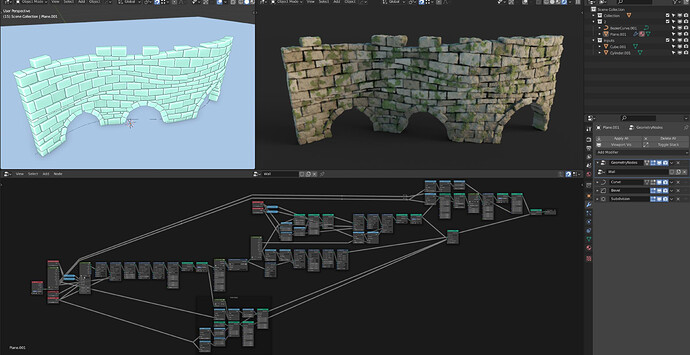Erindale Feedback on Procedural Wall
I (Dalai) asked Erindale to try to build a procedural wall inspired in the work by Marc Chevry. The goal was to identify any showstoppers and potential improvements for geometry nodes.
Here is the feedback:
Download the sample file.
Not 100% on what the curve tools Hans is working on covers but for this it would have been great to get the curve into the tree early and calculate its length to use for the wall length and then obviously at the end to conform the straight wall back to the curve similar to the curve modifier.
For me the ideal process would have been to make it flat and then extrude individual faces by a random amount. I think this would have made the booleans more robust as well.
I used my straight brick wall node and just removed random points from the top row and randomised the Y scale for bricks. That worked okay but it slowed everything up with the next lot of operations because it was having to make the bricks all real to get the uneven row heights. I was initially using a boolean straight after making the instances to trim the ends of the wall straight (because of the half brick offset between rows) but I worked out later that having any sort of operations after a boolean is practically unworkable. The performance just not production-ready with booleans at the moment. Luckily I was able to stick it at the end with the arch boolean without any issues in this case.
The arches themselves I just instanced a cylinder along the bottom using a narrow grid and a poisson disk distribution taking the max cylinder width for the minimum distance to prevent intersections. I would have prefered to interpolate curves from some generated points to get the arch and then mesh it for the boolean and in parallel, naturally parameterise for even space points and extrude it outwards and then extrude individual faces and bevel for the arched stone work. I had to instance bricks on the cyclinder boolean object which works from a distance but there’s very little control there and a lot of intersections.
I couldn’t do the fancy castellations on the top as in the reference without more specific edit mode operations (extrude / inset / selections etc) and also Ivy generation is something I wouldn’t like to try without loops and attribute processors / script nodes.
I ended up not needing the UV map definition steps at the end because it’s the kind of thing you can totally get away with procedural textures or triplanar mapping image textures
So the wishlist:
- Boolean performance needs to be 30x better. With the boolean node earlier in the tree (just after the first point instance of the cubes) calculating any changes to the tree was taking 20-30 seconds.
- More analytics nodes - face size / edge length / angle / curve length / face centre etc
- Solidify / Extrude Separate Faces with the ability to use an attribute containing a value per face to define extrusion depth which I think would need -
- Attribute Randomize working with other domains
- Attribute Vector Rotate node - A lot of people don’t know how to rotate a texture when it’s not using a UV map and a lot of cases like this won’t have UV maps
- Loop nodes - lots of use cases for this like recursive block subdivisions. The reference has random height divisions within blocks which I wasn’t able to imitate also could be used for packing different sized objects like the arches rather than only having 1 constant size to prevent intersections.
- Meshing points. I’ve seen the convex hull node task which is ace but we could really use some more deliberate meshing options as well. I’m not sure how that would work with the attribute workflow though. In Sverchok you have the UV connection node which will allow you to build surfaces based on list levels. With an attribute, if everything’s at the same level, how can it discern rows and columns?
- Simple operations like extruding by a LocRotScale matrix and into that comes point / edge / face selection
- Bevel node would be really handy too beveling but also creating support loops for subdiv
I know a bunch of that is in the works or planned but that was just what I came up against in this exercise!


 )
)